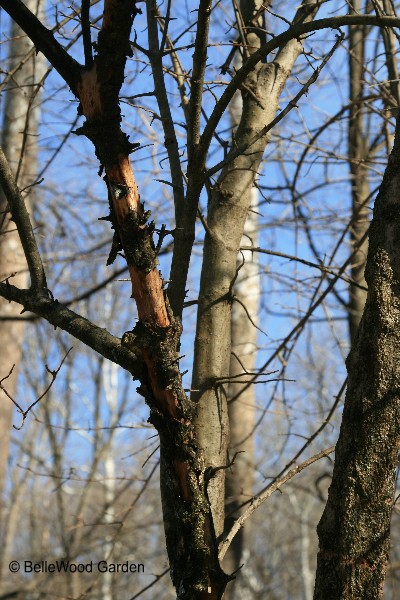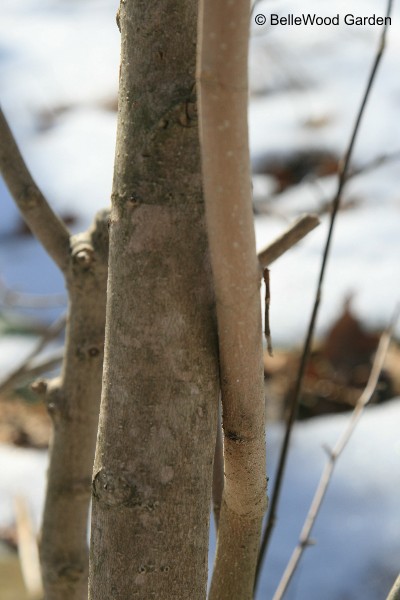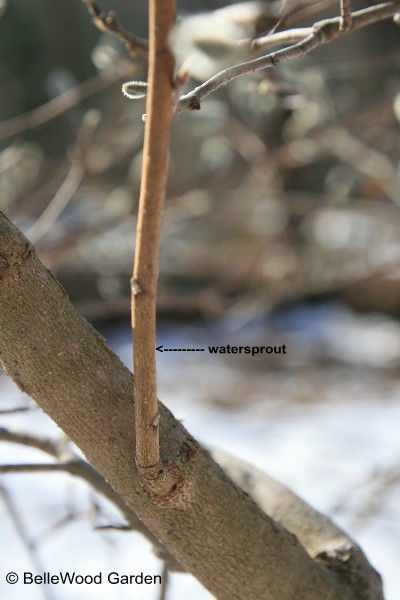
Seasonal Care of the Garden
On mild days, check for frost heaving. Donít try to push exposed roots back into the ground - theyíll only be damaged. Instead, cover with a layer of compost and sand, mixed in equal parts.
On a nice day, get outdoors and prune grapevines and non-stone fruits such as apple, pear, and quince. Remember to bring the fruit rees cut branches indoors for forcing: lay them in a bathtub and soak in tepid water for a few hours to soften the tight buds. Then arrange in a vase, removing buds below the water level. Enjoy the early flowers as a preview of those that will come in the Spring.
Prune winter damaged branches, weak branches, dead wood.

Anything obviously dead, like this bark-shedding example, is clearly good to go
- into the kindling box, that is. Use a tool appropriate to the task: clippers
(secateurs, if you want to speak Garden British) for small stuff,
loppers for somewhat larger, and a pruning saw for anything heavier.

Crossing branches should also be dealt with, since where they rub together
the bark will be damaged, allowing entry for insects and disease. Two choices -
cut one away. Or cut a fish-tail-like notch into each end of a very short piece of wood,
then wedge it between the two branches to keep them separate. Check periodically.
Eventually the two will stabilize into their new orientation, with space between them.
Now you can remove the brace. Keep watch that this problen does not reoccur.

This is called a watersprout. It is an undesirable, very vigorous
vertical shoot. Apple trees are very prone to this, as are magnolias.
Sometimes it is a tree's response to heavy pruning in the previous
growing season, and a good reason to rejuvenate overgrown shrubs
and trees over a three year period rather than all at once. Whatever
the reason, it is best to remove watersprouts earlier, rather than later.
Very small ones can be snapped away by hand. When they get as big
as the one shown here, clippers, loppers, or a saw come into play.
Spray fruit trees, lilacs, etc. with a dormant oil when temperature is above 45į Fahrenheit. That allows the water in the spray to dry before it might freeze and cause damage. Spraying now is effective for protection against scale insects, and also smothers insect eggs.
Sow seed of rock garden and native plants, and hardy perennials that need freezing temperatures to germinate.
Indoors sow seed of begonias and petunias, which need a long time from seed to flower. Itís only worthwhile to grow them from seed if you want a cultivar thatís difficult to find. Eggplant should also be started in mid- to late February, for planting out in the garden when the weather is mild and settled. Start broccoli, cabbage, leeks for planting out when temperatures are moderating but night frosts may still be anticipated.
If you want to start caladiums from dormant tubers, now's the time. They want bottom warmth from a heating mat. Will a flat with damp peat moss, and nestle each tuber into the growing medium. If you plant the tubers as received from the vendor, your plants will have fewer leaves, but they will be larger. Or, you can use a melon baller to scoop out the little nubbin of a growing point. Secondary shoots will then awaken and grow, resulting in more numerous, but smaller leaves.
Time to peruse the catalogs and place you orders for summer-blooming bulbs, uncommon perennials, and trees and shrubs in smaller sizes.